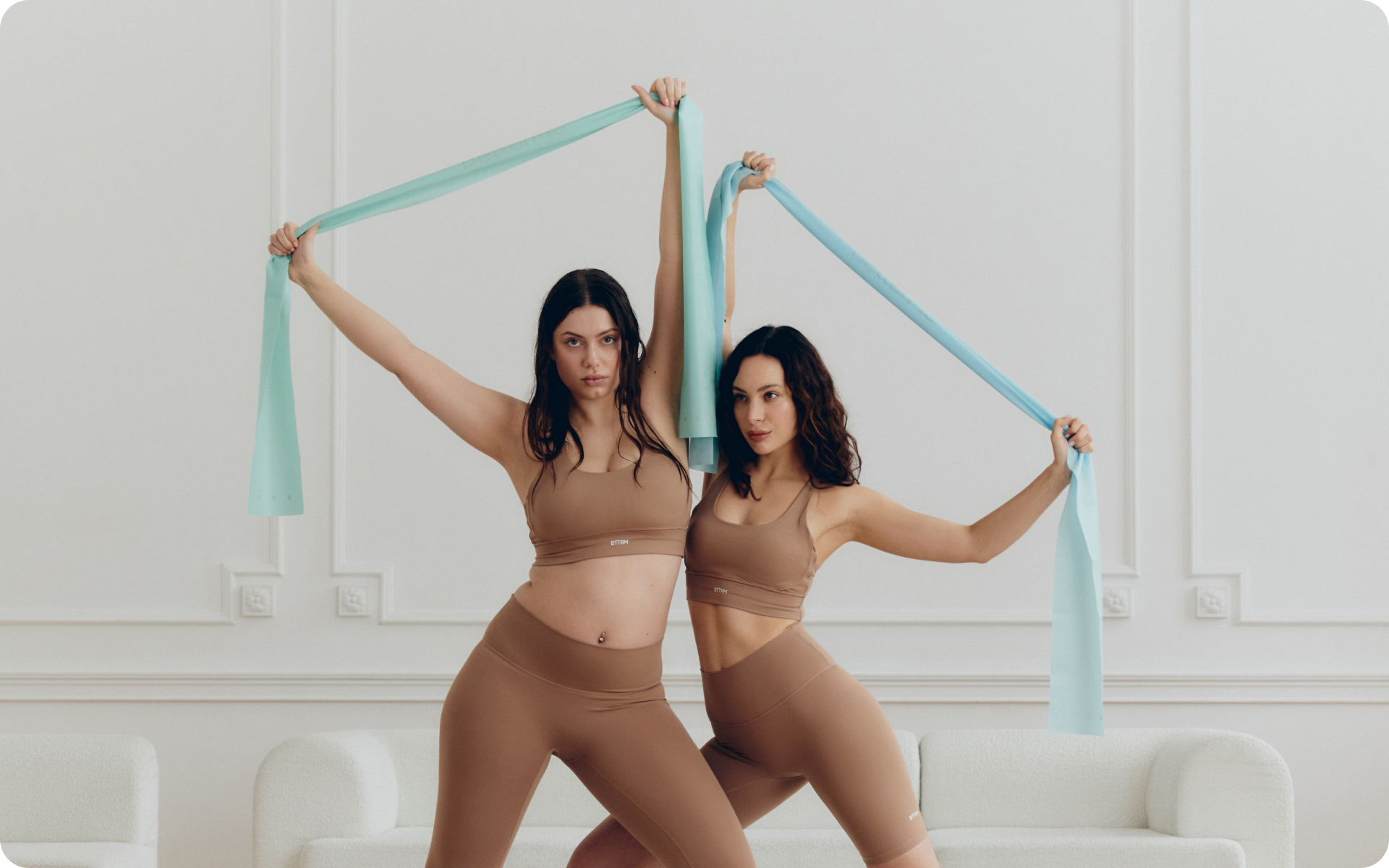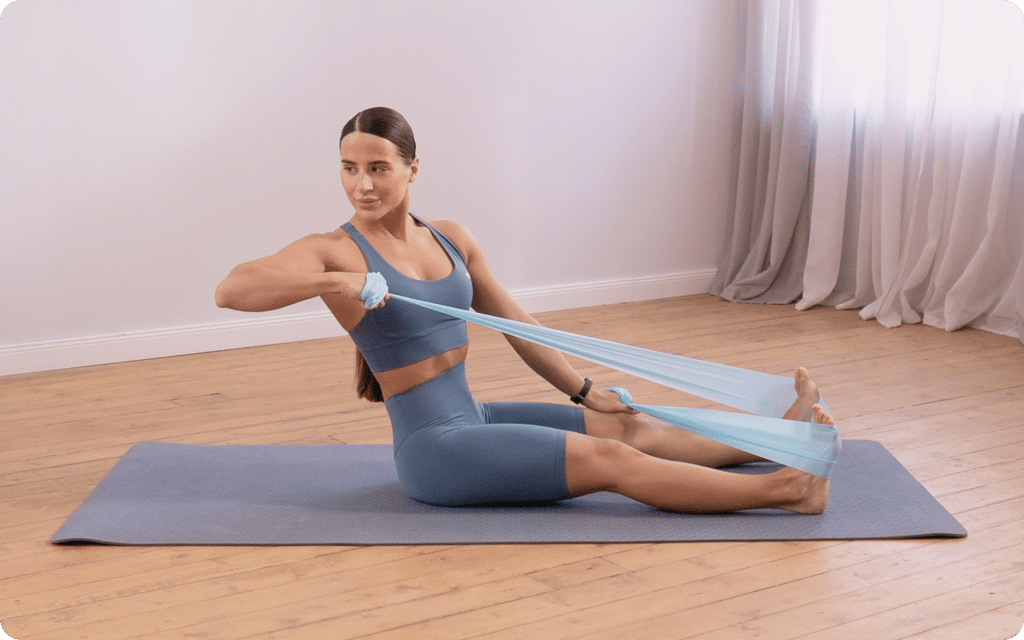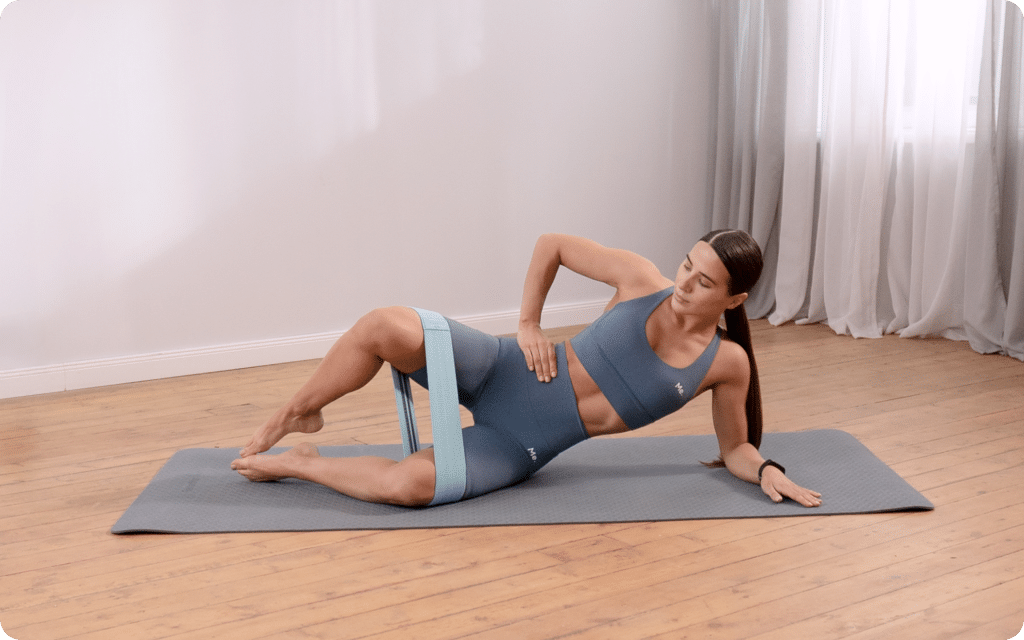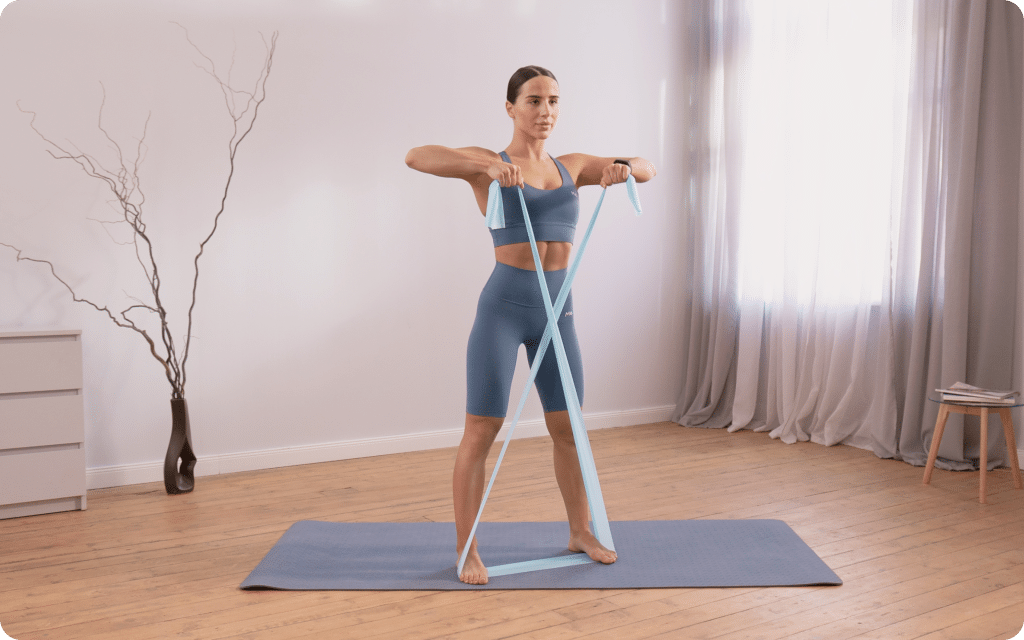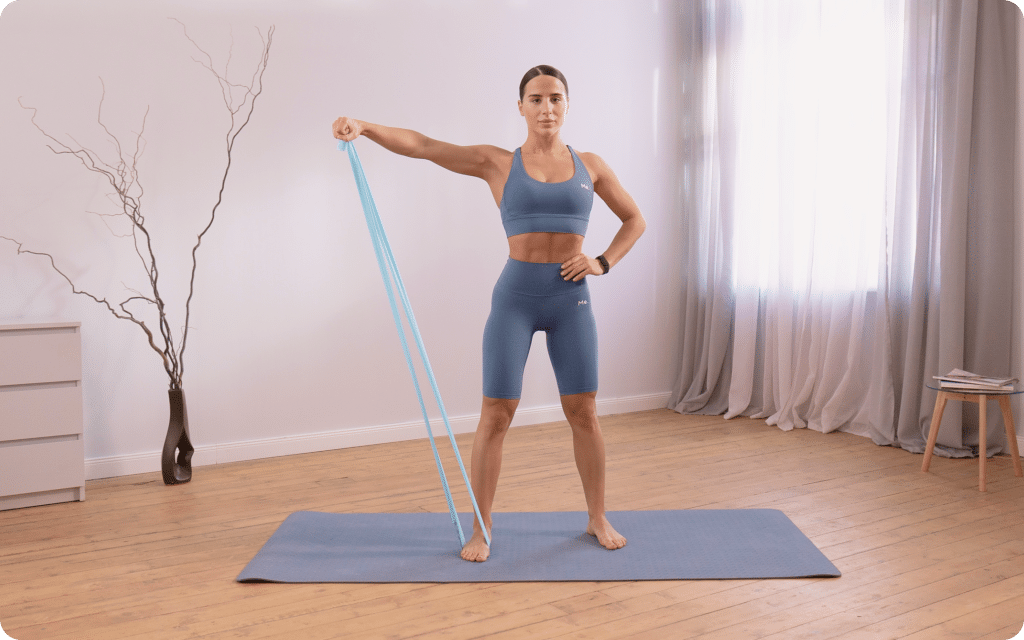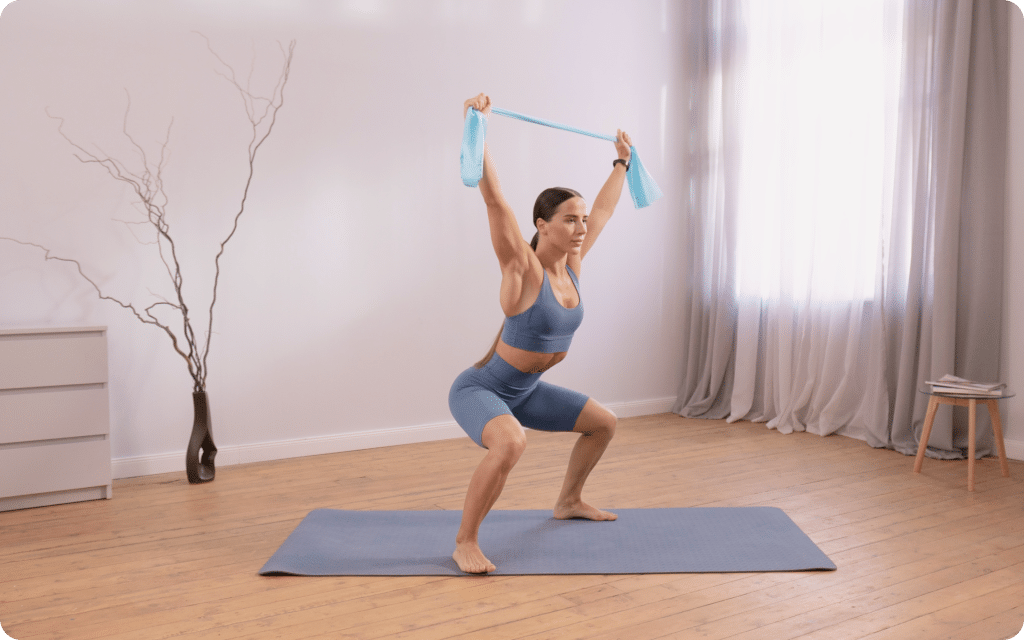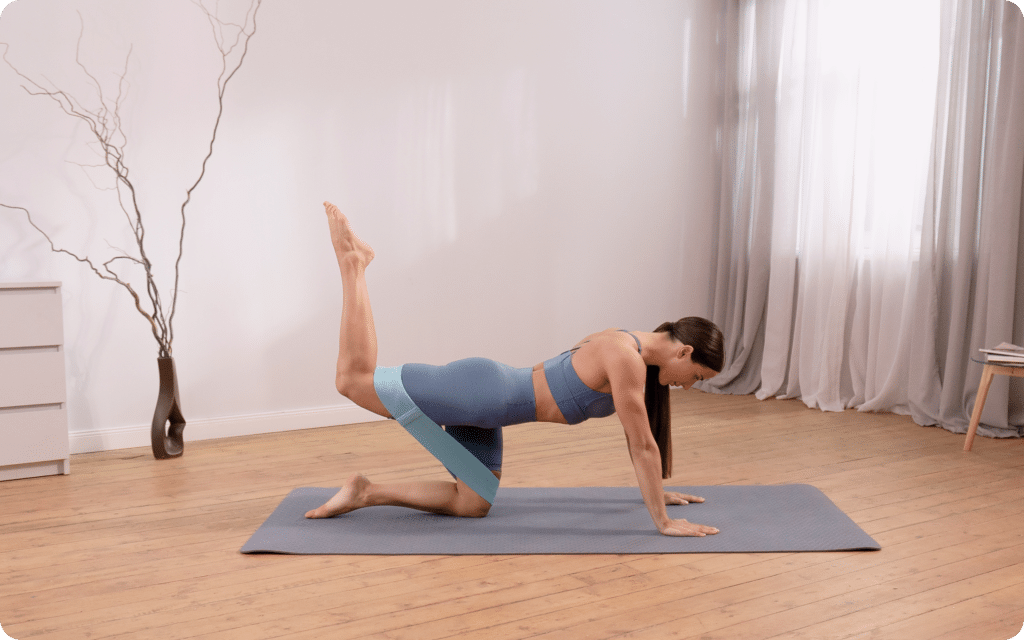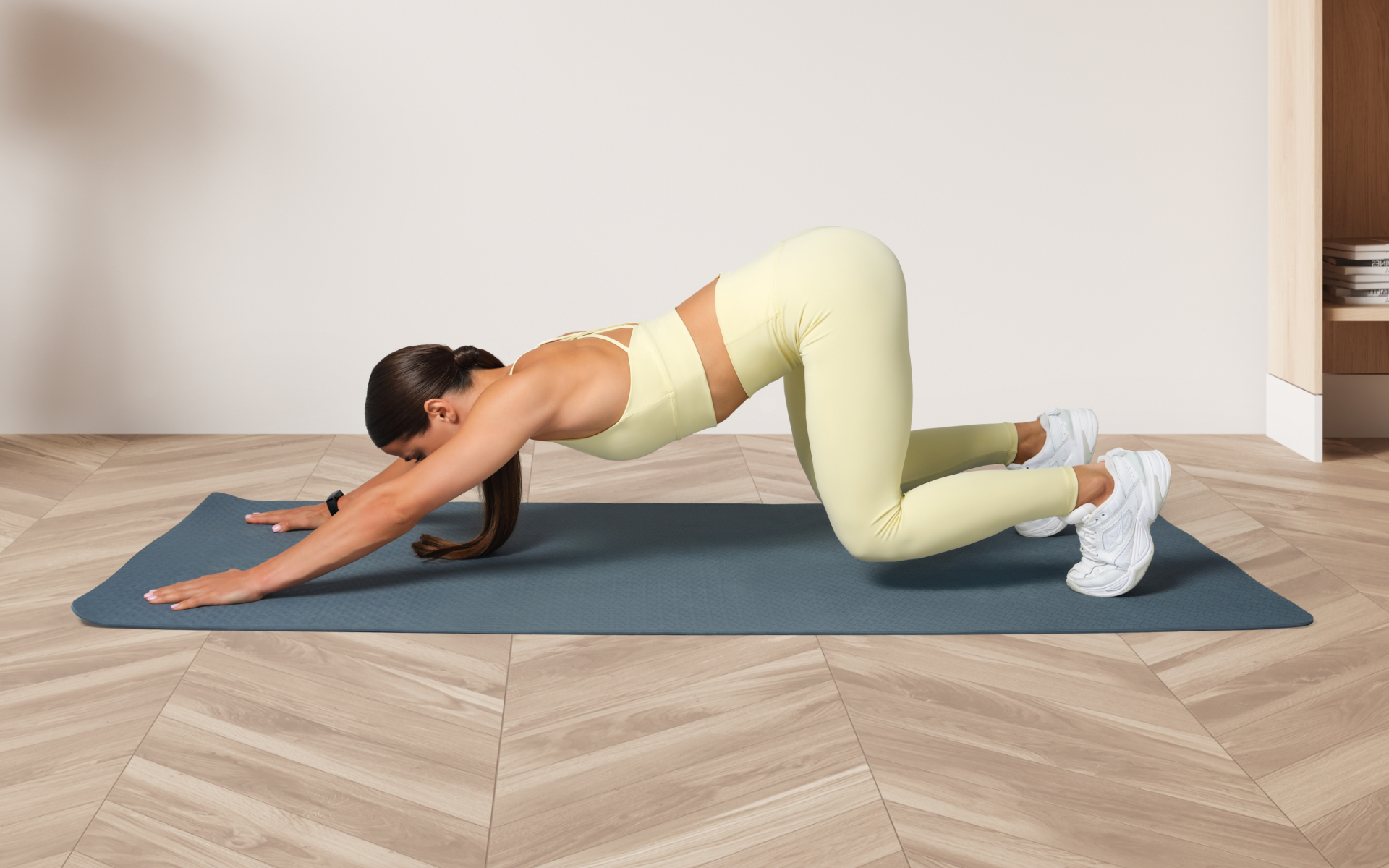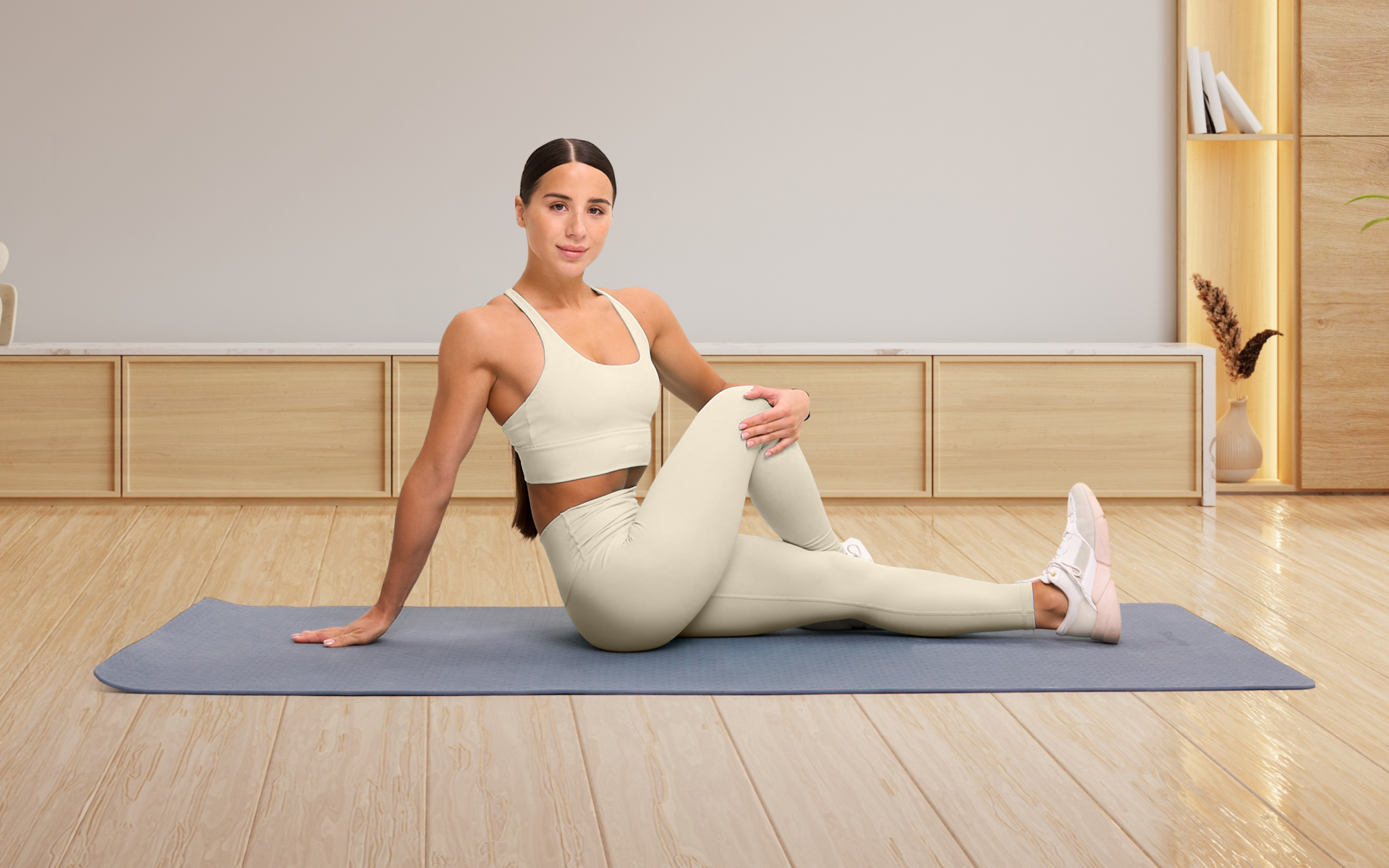Mat Pilates is as popular as ever, and for good reason. It’s a low-impact form of exercise that can improve strength, flexibility, and overall body awareness. But sometimes it’s nice to switch things up and add some variety to your Pilates routine.
Enter: resistance bands.
Resistance bands are an affordable and portable way to amp up your Pilates workout.
They provide an extra challenge and help target specific muscle groups.
Plus, using resistance bands can have a lower impact on joints compared to traditional weights. Many create resistance bands full body workouts to meet their needs.
Here are 7 exercises for a Pilates resistance band workout at home, and everything else you need to know.
What Is A Pilates Resistance Band Workout Designed To Target?
A Pilates resistance band workout is not just about strengthening specific muscles; it’s a way to engage the entire body on multiple physiological levels, offering a unique approach to movement and exercise.
When you incorporate resistance bands into a Pilates resistance bands workout for beginners, and all fitness levels, they can increase the complexity of each exercise by introducing variable tension:
1. Progressive Resistance and Muscle Activation
Resistance bands create progressive resistance, meaning the force increases as the band stretches. This increased force triggers continuous muscle engagement throughout the entire range of motion (1).
Unlike weights, which rely on gravity and can feel easier at specific points of the lift, bands provide consistent tension.
This tension requires your muscles to work harder to maintain control during both the contraction and relaxation phases of a movement, emphasizing eccentric (lengthening) muscle activation, which is crucial for achieving balanced strength and injury prevention (2).
2. Improved Joint Stability
The elasticity of resistance bands introduces an element of instability to every movement, which demands greater joint stabilization.
For example, in exercises like the plank or side-lying leg lifts, the bands force surrounding stabilizing muscles to activate to maintain a stable position.
This muscle activation can benefit smaller, underutilized muscles that tend to be overlooked in traditional resistance training, leading to improved functional joint mechanics and a reduced risk of injury (3).
3. Enhanced Neuromuscular Coordination
One of the most valuable benefits of including resistance bands in Pilates is their impact on neuromuscular coordination. The body’s ability to coordinate muscles into smooth, efficient movement patterns relies on proper communication between the brain and muscles (4, 5).
Resistance bands challenge this system through dynamic, multi-directional tension, encouraging your body to recruit different muscles simultaneously (4, 5).
This brain-muscle connection is beneficial for promoting balance, alignment, and controlled movement.
4. Variable Resistance for Customization
Resistance bands allow for variable resistance, meaning you can adjust the difficulty level by changing the amount of stretch or by using different band intensities.
Physiologically, this means your body must adapt to specific force thresholds, which contributes to improved endurance and muscular efficiency over time (6, 13).
This adaptability is invaluable for transitioning between different fitness levels or for rehabilitation after injuries.
When it comes to weight loss, progress is made by inches, not miles, so it’s much harder to track and a lot easier to give up. The BetterMe: Health Coaching app is your personal trainer, nutritionist, and support system all in one. Start using our app to stay on track and hold yourself accountable!
5. Core Engagement and Dynamic Stability
Pilates emphasizes core stability, and resistance bands amplify this focus.
The added tension requires continuous engagement of the deep core muscles, such as the transverse abdominis and pelvic floor, to maintain posture and alignment (7).
Additionally, as bands often pull your limbs in opposing directions or create resistance in asymmetrical patterns, they demand dynamic stability, teaching the body to maintain control even under challenging circumstances.
6. Mind-Muscle Connection
Pilates already places a strong emphasis on mindfulness in movement, and the introduction of resistance bands enhances this connection (8).
The physical feedback from the band helps you become more aware of your movement patterns. It encourages you to move with precision, ensuring proper form and alignment, which can improve motor learning and reduce compensatory movements.
Read more: BetterMe Home Pilates Kit: Your Perfect Companion for Home Workouts
Do Pilates Resistance Bands Work?
Pilates with resistance bands for beginners and all fitness levels is ideal.
Research published in the Journal of Physical Therapy Science has demonstrated that resistance band training can significantly improve muscle strength and flexibility, particularly among older adults (9).
Further, a study published in the Journal of Strength and Conditioning Research found that resistance band exercises elicit significant muscle activation, particularly in the upper body (1).
Many use resistance bands in physical therapy and rehabilitation settings due to their ability to provide controlled resistance without overloading joints.
The Pilates resistance band exercise is a well-documented practice in clinical settings (3)
Using these versatile tools can be beneficial for anyone, regardless of their fitness level or goals.
Can You Get In Shape With Just Resistance Bands?
To a degree, you can. Resistance bands are highly versatile tools that can improve various aspects of fitness; however, complete physical conditioning may require a combination of different exercise modalities.
Here’s a breakdown:
What Resistance Bands Can Improve
- Muscular Strength and Endurance: Bands provide progressive resistance, helping you build strength and sustain muscle activation over time (1).
- Flexibility and Mobility: They aid in controlled stretches that improve joint range of motion without overstressing the tissues (9).
- Core Stability: Many resistance band exercises engage the core dynamically, helping to improve posture and stability (7).
- Coordination and Balance: The band’s elasticity challenges stability, requiring greater neuromuscular control (4).
What Might Need Supplemental Exercise
- Cardiovascular Fitness: Resistance bands are not ideal for sustained, high-intensity activities like running, cycling, or swimming, which improve cardiovascular function (10).
- Bone Density: While bands create resistance, weight-bearing exercises like walking or lifting heavier loads may be more effective in improving bone health (11).
- Explosive Power: Activities like jumping, sprinting, or Olympic lifting are typically more effective for building speed and power (12).
While resistance bands are excellent for achieving specific goals, a well-rounded fitness regimen typically includes a combination of resistance training, aerobic exercise, and weight-bearing activities for balanced development.
What Is An Effective Pilates Resistance Bands Workout?
Warm-Up:
- Arm Circles with Resistance Band: 2 sets of 10 circles in each direction, no rest between.
Main Workout:
- Roll-Up with Resistance Band: 2 sets of 8–10 reps, 30 seconds rest between sets.
- Single-Leg Stretch with Resistance Band: 2 sets of 8–10 reps per leg, 30 seconds rest between sets.
- Seated Row with Resistance Band: 3 sets of 10–12 reps, 30 seconds rest between sets.
- Banded Side-Lying Leg Lifts: 2 sets of 12–15 reps per side, 20 seconds rest between sides.
- Banded Bridge: 3 sets of 10–15 reps, 30 seconds rest between sets.
- Resistance Band Plank with Arm Reach: 2 sets of 8–10 reps per arm, 30 seconds rest between sets.
Cool-Down:
- Perform light stretching using the resistance band for 2–3 minutes, focusing on the hamstrings, shoulders, and back.
1. Roll-Up with Resistance Band
The roll-up is a classic Pilates move, and adding a resistance band makes it even more challenging for your core while aiding flexibility.
How to Perform
- Sit with your legs extended straight in front of you, feet hip-width apart. Loop the resistance band around the soles of your feet and hold the ends in your hands.
- Sit tall, engaging your core, and pull slightly on the band to maintain tension.
- Slowly roll down through your spine, one vertebra at a time, until your back is flat on the mat.
- Use your core to roll back up with control, returning to a seated position.
- Repeat 8–10 times.
2. Single-Leg Stretch with Resistance Band
A Pilates staple, the single-leg stretch is enhanced with a resistance band, making it even more challenging for the core and hip flexors.
How to Perform
- Lie on your back with your knees bent, feet flat on the mat.
- Hold the resistance band in both hands and loop it around the arch of one foot.
- Extend that leg toward the ceiling while the other leg remains bent.
- Lift your head, neck, and shoulders off the mat, keeping your core engaged.
- Extend the banded leg outward at a 45-degree angle, pulling lightly on the band for resistance, then return it to the starting position.
- Switch legs and repeat for 8–10 reps per leg.
3. Banded Side-Lying Leg Lifts
Side-lying leg lifts work your hips, glutes, and outer thighs, improving stability and alignment. This movement falls into the Pilates band exercises for legs.
How to Perform
- Place the resistance band around both thighs, just above your knees.
- Lie on one side with your legs stacked and your head resting on your bottom arm.
- Keeping your core engaged, lift the top leg against the band’s resistance and lower it back down slowly. Avoid letting the band snap your leg back.
- Perform 10–15 reps per side.
4. Seated Row with Resistance Band
This move strengthens the back, shoulders, and arms while improving posture.
How to Perform
- Sit tall with your legs extended straight out in front of you.
- Loop the resistance band securely around the soles of your feet and hold the ends with both hands, palms facing each other.
- Keep your chest lifted and shoulders relaxed. Pull the band toward your torso by bending your elbows, keeping them close to your sides, and squeezing your shoulder blades together.
- Slowly extend your arms to return to the starting position.
- Do 10–12 reps.
5. Resistance Band Plank with Arm Reach
This advanced exercise engages your core and shoulder stability, making planks even more effective.
How to Perform
- Loop the resistance band around your wrists and get into a forearm plank position with your elbows directly under your shoulders.
- Keeping your core tight, slowly reach one arm forward, pulling against the band as far as you can without losing stability.
- Return to the plank and switch arms.
- Alternate for 8–10 reps on each side.
6. Banded Bridge
This variation of the bridge exercise intensifies glute engagement with the band.
How to Perform
- Place the resistance band just above your knees and lie on your back with your feet flat and hip-width apart.
- Engage your glutes and lift your hips until your body forms a straight line from shoulders to knees.
- Press your knees outward against the band’s resistance and slowly lower back down.
- Repeat for 10–15 reps.
7. Arm Circles with Resistance Band
This simple but effective move tones your shoulders, arms, and upper back.
How to Perform
- Hold the resistance band tightly between your hands, stretching it to create tension. Extend your arms straight out in front of you at shoulder height.
- Slowly draw small circles with your arms, keeping the band stretched throughout.
- Reverse the direction after 10–12 repetitions.
- Maintain steady breathing and proper posture throughout.
These Pilates resistance bands exercises are excellent for improving agility and strength.
Read more: How Does Pilates Help Your Body Function Better?
Is Pilates Enough For Resistance Training?
Pilates can be enough for resistance training. Pilates incorporates resistance in various forms, such as body weight, springs, or resistance bands, making it an effective way to build strength and stability. However, for comprehensive resistance training, it is essential to consider certain limitations.
Here’s a closer look:
Resistance Training Benefits of Pilates
- Improves Muscle Endurance: Pilates focuses on controlled, repetitive movements that strengthen muscles over time without bulky gains (13).
- Enhances Core Strength: Almost every Pilates exercise centers on engaging the core, fostering functional strength and stability in the midsection (7).
- Supports Joint Health: Its emphasis on controlled motion and resistance improves joint mobility while reducing strain (14).
- Offers Low-Impact Strengthening: Pilates is ideal for those seeking gentle resistance work that minimizes impact on the joints.
Where Pilates May Fall Short
- Limited Progressive Overload: While at home pilates equipment like reformers adds resistance, they may not provide the progressive overload necessary for significant muscle hypertrophy.
- Lacks Heavy Resistance: Pilates typically doesn’t involve heavy loads, crucial for maximizing muscle strength and bone density.
- Minimal Focus on Explosive Power: Pilates routines do not emphasize activities requiring fast, forceful muscle contractions (e.g., sprints, plyometric exercises).
- Limited Upper Body Strength Development: While Pilates promotes overall balance, it may not provide enough resistance for significant upper body strength gains compared to traditional weightlifting.
Pilates offers many benefits for general strength and stability, but those seeking to optimize muscle growth or achieve specific resistance training goals may need to complement it with other modalities.
Is It Ok To Workout With Resistance Bands Everyday?
Working out with resistance bands daily can be acceptable, provided the routines are low to moderate intensity and allow for adequate muscle recovery.
Resistance bands are gentle on joints and versatile, making them suitable for daily use, particularly for improving flexibility, mobility, or light resistance training.
However, for higher-intensity sessions that target muscle strength, rest days are essential to allow muscle fibers to repair and grow. Listening to your body and varying muscle groups or intensity levels is key to avoiding overuse injuries and maintaining balanced progress.
How To Choose Pilates Resistance Bands Wisely?
When choosing a Pilates resistance band, consider:
- Material and Durability: Look for high-quality latex or fabric bands that resist snapping and maintain elasticity over time.
- Resistance Levels: Choose a set with varied resistance levels to tailor workouts to your strength and progression.
- Length and Size: Longer bands offer greater versatility for Pilates movements, accommodating a wider range of poses and exercises.
- Comfort and Grip: Bands with non-slip textures or padded handles improve comfort and prevent slippage during use.
BetterMe: Health Coaching app helps you achieve your body goals with ease and efficiency by helping to choose proper meal plans and effective workouts. Start using our app and you will see good results in a short time.
Avoid making these mistakes:
- Buying Without Testing Resistance: Using a band that’s too light or heavy can limit effectiveness and lead to unsatisfactory results.
- Overlooking Measurements: Bands that are too short or narrow may restrict movement or fail to support your workout goals.
- Ignoring Quality for Cost: Cheap bands can lack durability and may wear out quickly, posing a safety risk.
- Choosing Based on Appearance: Focus on functionality and quality rather than aesthetics when making your selection.
For a reliable option, consider the BetterMe long resistance band. It’s well-suited for Pilates and offers the versatility and quality needed to enhance your workouts effectively.
Resistance bands can support core strengthening exercises, which contribute to a flatter stomach by improving muscle tone and definition. However, achieving a truly flat stomach also depends heavily on maintaining a calorie deficit, proper nutrition, and overall reduction in body fat. Avoid using resistance bands that are damaged or start to fray, as they can snap and cause injury. Don’t overstretch the band beyond its capacity, as this can reduce its durability. Also, avoid poor form during exercises, which can lead to strain or ineffective workouts. Resistance bands are effective for targeting and strengthening the glutes when used with exercises such as squats, hip thrusts, or kickbacks. While they enhance muscle activation, significant growth may require a combination of progressive overload, such as adding weights, and a proper nutritional plan. Yes, rest days are essential, particularly if your workouts focus on higher-intensity or muscle-strengthening exercises. Rest allows muscle fibers to repair and recover, promoting growth and preventing overuse injuries. For light mobility or stretching routines, daily use is generally acceptable.Frequently Asked Questions
Can you get a flat stomach with resistance bands?
What should you not do with resistance bands?
Can resistance bands grow glutes?
Do you need rest days with resistance bands?
The Bottom Line
A Pilates resistance band workout doesn’t isolate just one system. Instead, it integrates strength, stability, flexibility, and coordination into a cohesive whole.
By combining the principles of Pilates with the versatility of resistance bands, you engage the body in a comprehensive, functional way that promotes overall movement quality, joint health, and body awareness.
It’s a well-rounded approach designed to challenge your body while respecting its limits, making it suitable for a variety of fitness levels and goals.
DISCLAIMER:
This article is intended for general informational purposes only and does not serve to address individual circumstances. It is not a substitute for professional advice or help and should not be relied on for making any kind of decision-making. Any action taken as a direct or indirect result of the information in this article is entirely at your own risk and is your sole responsibility.
BetterMe, its content staff, and its medical advisors accept no responsibility for inaccuracies, errors, misstatements, inconsistencies, or omissions and specifically disclaim any liability, loss or risk, personal, professional or otherwise, which may be incurred as a consequence, directly or indirectly, of the use and/or application of any content.
You should always seek the advice of your physician or other qualified health provider with any questions you may have regarding a medical condition or your specific situation. Never disregard professional medical advice or delay seeking it because of BetterMe content. If you suspect or think you may have a medical emergency, call your doctor.
SOURCES:
- Effects of training with elastic resistance versus conventional resistance on muscular strength: A systematic review and meta-analysis (2019, journals.sagepub.com)
- The Health and Functional Benefits of Eccentric versus Concentric Exercise Training: A Systematic Review and Meta-Analysis (2023, pmc.ncbi.nlm.nih.gov)
- Efficacy of resistance training with elastic bands compared to proprioceptive training on balance and self-report measures in patients with chronic ankle instability: A systematic review and meta-analysis (2023, sciencedirect.com)
- Acute Effects of Elastic Bands as Resistance or Assistance on EMG, Kinetics, and Kinematics During Deadlift in Resistance-Trained Men (2020, frontiersin.org)
- Effects of Replacing Free Weights With Elastic Band Resistance in Squats on Trunk Muscle Activation (2014, journals.lww.com)
- Exercise Physiology (2024, ncbi.nlm.nih.gov)
- The Relationship of Trunk Muscle Activation and Core Stability: A Biomechanical Analysis of Pilates-Based Stabilization Exercise (2021, mdpi.com)
- Pilates and Mindfulness: A Qualitative Study (2012, tandfonline.com)
- Effects of elastic-band resistance exercise on balance, mobility and gait function, flexibility and fall efficacy in older adults (2016, jstage.jst.go.jp)
- PHYSICAL ACTIVITY AND YOUR HEART (2022, nhlbi.nih.gov)
- Exercise for Your Bone Health (2023, niams.nih.gov)
- Training Strategies to Improve Muscle Power Is Olympic-style Weightlifting Relevant? (2017, journals.lww.com)
- Is pilates better than other exercises at increasing muscle strength? A systematic review (2022, pmc.ncbi.nlm.nih.gov)
- Effects of Pilates exercises on spine deformities and posture: a systematic review (2024, bmcsportsscimedrehabil.biomedcentral.com)
